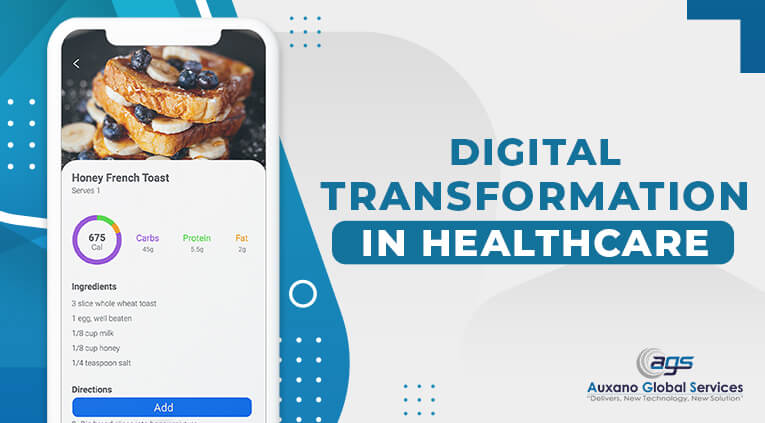The trend of wearable apps in the healthcare sector is gaining momentum with the emergence of mobile technology. This new wave of digital transformation has made it possible to access health-related information and services conveniently. Wearable applications have made it easier for healthcare professionals to manage their data, monitor patient health, and keep track of vital signs.
Wearable app development has opened up a world of opportunities for healthcare providers to bring advanced medical assistance and improved patient care with the help of revolutionary technologies. In this article, let’s explore how wearable app development is taking healthcare to the next level, but before that, let’s look at some statistics.
Healthcare Wearable Industry Statistics
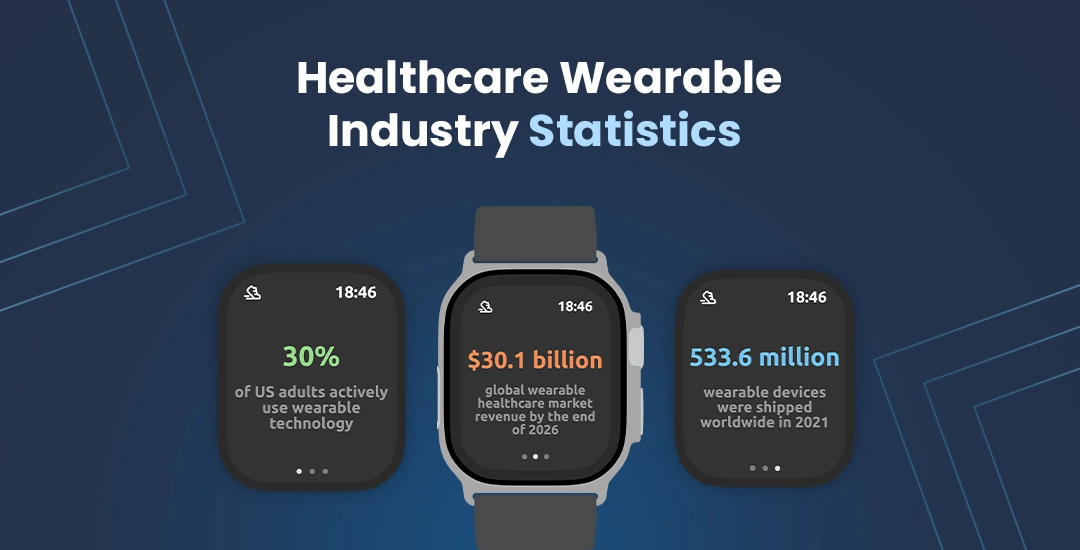
1. According to reports, the global wearable healthcare market revenue was around $16.2 billion, and it’s all set to touch the mark of $30.1 billion by the end of 2026. This market is growing with a CAGR of 13.2% from 2021 to 2026.
2. Around 30% of US adults actively use wearable technology to support their health. Moreover, approximately 50% of users rely on this advancement for daily operations, with more than 80% willing to share their healthcare data with their doctors.
3. In 2021, around 533.6 million wearable devices were shipped worldwide, and the hearing aid devices category was at the top. The “hearables” or earwear devices category will reach 105 million by the end of 2024.
These statistics indicate the ever-growing trend of wearable technology in healthcare, mainly due to its advantages. Let’s now look at some of the essential growth factors of this industry:
Factors Leading To The Rise Of Medical Wearables
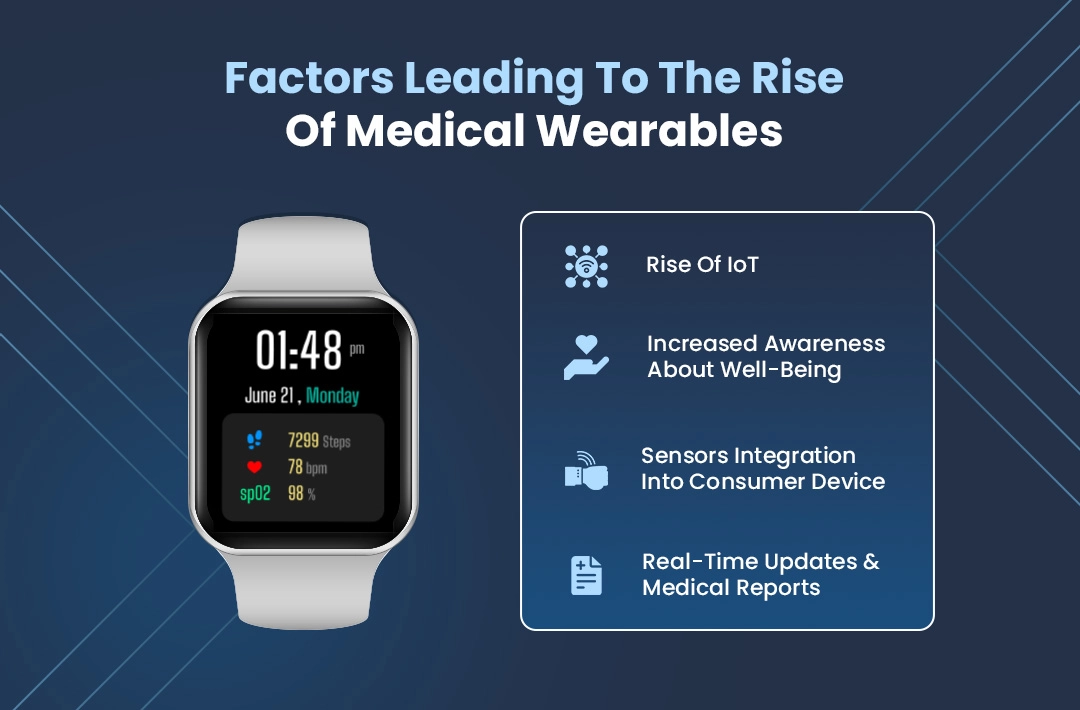
1. Rise Of IoT
The surge in demand for wearable medical devices is mainly attributed to the increasing Internet of Things (IoT) penetration. IoT is a network of connected devices, allowing them to interact with each other.
This has made it easier for medical wearables to collect and share data with healthcare providers and patients, thus simplifying the process of monitoring health. As most smartphones support full-fledged IoT, medical wearables can easily be integrated into it to create a comprehensive health data network.
2. Increased Awareness About Well-Being
Post-COVID-19, there has been an increased awareness about well-being and health. This has led to a surge in demand for medical wearables, as they provide a more convenient way to monitor one’s health status from anywhere proactively. Patients are now taking active steps towards managing their health by using these devices, which is driving up their adoption.
Furthermore, social media is also playing an instrumental role in spreading awareness about these devices and inspiring people to use them. In the future, this is expected to be one of the major factors driving their adoption.
3. Sensors Integration Into Consumer Device
Medical wearables are also benefiting from the integration of sensors into consumer devices. With the help of advanced sensors, these devices can perform various tasks, such as monitoring heart rate and blood pressure. This has simplified the data collection process for patients, allowing them to get real-time updates about their health without having to visit a doctor.
In addition, doctors are also recommending their patients use these devices for long-term health monitoring. As healthcare professionals have access to patients’ real-time data, they can provide precise treatment and help them take preventive measures against illnesses. It has been a major factor driving the growth of the medical wearables market.
4. Real-Time Updates And Medical Reports
Another factor driving the demand for medical wearables is their ability to provide real-time updates and generate medical reports. These devices can collect data from a patient’s body, such as heart rate, sleep patterns, and blood pressure, and then deliver this information in real time on associated mobile apps or other connected devices.
Real-time updates are crucial for monitoring patient health, as they allow healthcare professionals to act quickly if any changes in the patient’s condition are detected. Medical reports generated by these devices can also be used to track chronic illnesses and monitor the effectiveness of treatment over time.
After exploring these factors, let’s look at why these wearable devices are the future of 2024 and beyond for the healthcare industry.
Why Are Wearables The Future Of 2024 And Beyond?
The development of wearables is rapidly accelerating, and in the next few years, we can expect to see these devices become more widely used than ever before. Wearables are becoming increasingly powerful, offering consumers the ability to stay connected and monitor their health in real time. Below are the two key reasons why wearables are the future of 2024 and beyond.
1. Increased Connectivity
Wearables are becoming increasingly connected, allowing users to access their data in real time and communicate via text, email, and other forms of communication. This allows users to stay connected even when they’re away from their computers or phones.
Many wearables, such as smartwatches and fitness trackers, also offer robust tracking capabilities, allowing users to track their activity levels and progress on specific goals.
2. Improved Health Monitoring
Wearables are also helping to improve health monitoring, allowing users to track vital signs such as heart rate and blood pressure in real-time. This ability gives users the information they need to make informed decisions about their health and wellness.
With a holistic approach to tracking and monitoring health, we can expect to see significant improvements in healthcare in the future. In addition, many wearables can now integrate with other medical devices, allowing even more detailed tracking and analysis of a user’s health. After exploring these reasons, let’s understand the types of wearables available in the market.
Types Of Wearables Available In The Market
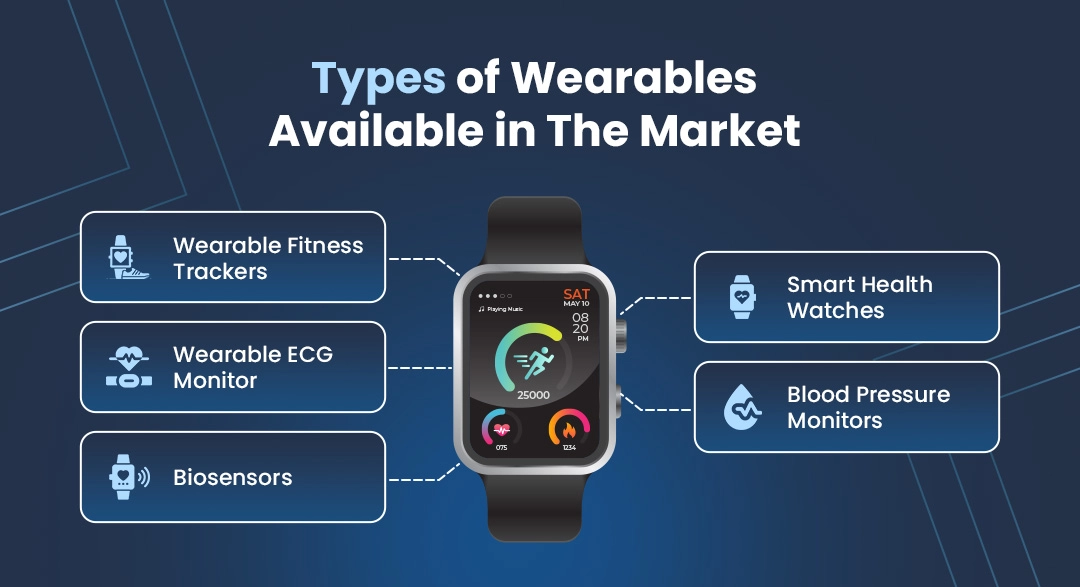
1. Wearable Fitness Trackers
These are the most popular type of wearables, and they come in various sizes and styles, but all feature built-in sensors that track your activity, such as steps taken, calories burned, and heart rate. Many also include additional features like a digital display or smartphone app integration.
2. Smart Health Watches
A smart health watch is similar to a fitness tracker but has additional features that allow it to measure more advanced metrics like blood pressure, sleep quality, oxygen levels, and more. These wearables are usually worn on the wrist and often come with a color display that can be used to view your overall health data.
3. Wearable ECG Monitor
Wearable ECG monitors are designed to measure the electrical signals from your heart, allowing you to detect potential issues before they become serious. These devices are usually worn on the wrist and feature sensors that detect changes in your heartbeat. These are handy for those who have been diagnosed with a heart condition or are at risk of developing one.
4. Blood Pressure Monitors
These wearables are designed to measure your blood pressure and track your health over time. They usually look like a wristwatch and come with sensors that detect changes in your blood pressure. Many of these devices can also be synced to a smartphone app, allowing you to view your health data easily.
5. Biosensors
Biosensors are small, wearable devices that measure various biological signals from the body. These can include anything from skin temperature to glucose levels and can be used to monitor a variety of health conditions. Many biosensors are designed to be paired with a smartphone or other smart device, making viewing your data on the go easy.
On this note, let’s look at some of the key advantages of wearable app development for healthcare.
Advantages of Wearable Technology
Before you get started with wearable app development, it’s crucial to understand how your app can benefit from the power of wearable technology. Here are some of the primary advantages:
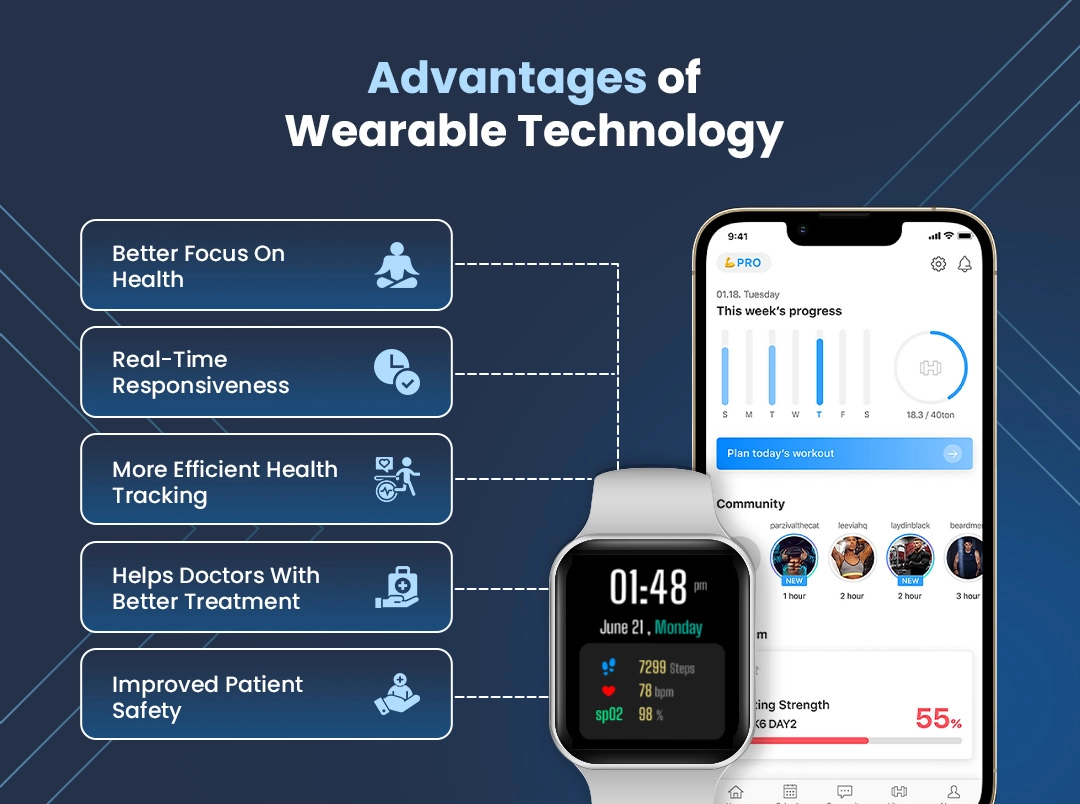
1. Better Focus On Health
Wearable technology devices can be used to track your daily physical activity and health metrics, including steps taken, heart rate, calories burned, etc. Data collected can be used to set goals and better monitor your health habits. Earlier, it was not possible for users to gain insight into their health activities.
With the help of wearable technology, users can now easily track their physical activity and make changes based on the data collected. As the past data is available, users can use it to compare their progress over time and better understand the impact of their efforts. This allows them to focus more on their health and make changes resulting in a healthier lifestyle.
2. Real-Time Responsiveness
Wearable devices are known to be extremely quick and responsive. As they are constantly connected to the internet, they can quickly react to changes in an environment and provide alerts when necessary. This allows users to stay informed about their surroundings and remain safe.
For example, fitness trackers can alert users when they need more water or if their heart rate is too high. This helps them remain aware of their present health condition and take necessary preventive measures against any potential risk.
3. More Efficient Health Tracking
With the help of wearable technology, users can track their health efficiently and accurately. Data collected by wearables is generally more precise than manual data collection, allowing users to understand their progress over time better.
Moreover, as these devices are always connected to the internet, they provide essential updates related to health and fitness. This helps users stay up-to-date with their progress and take measures to improve their health conditions.
4. Helps Doctors With Better Treatment
Wearable technology allows doctors to have better insight into their patient’s health. This helps them make an accurate diagnosis and provide better treatment plans. Data collected by wearables also help doctors understand the effectiveness of a particular medicine or therapy on a patient.
As they have real-time access to this data, they can quickly adjust treatments as per the patient’s condition. This helps them provide more precise treatment and faster recovery. Furthermore, data collected by wearables can be used to monitor and predict a patient’s health condition, which helps with the early detection of any potential issues.
5. Improved Patient Safety
Wearable technology can monitor a patient’s health even when away from the hospital. This helps doctors remain informed about their condition and take preventive actions if necessary.
Moreover, wearables can also be used to detect any sudden changes in the patient’s condition before they become serious.
With devices like smartwatches, patients can also be reminded to take their medications at the right time. This helps them remain healthy and reduces the chances of any health-related issues.
Overall, wearable technology is transforming the way we monitor our health and stay safe. Now, let’s move towards healthcare app development and how it can transform the entire industry.
How Will Healthcare Wearable App Development Transform The Entire Industry?
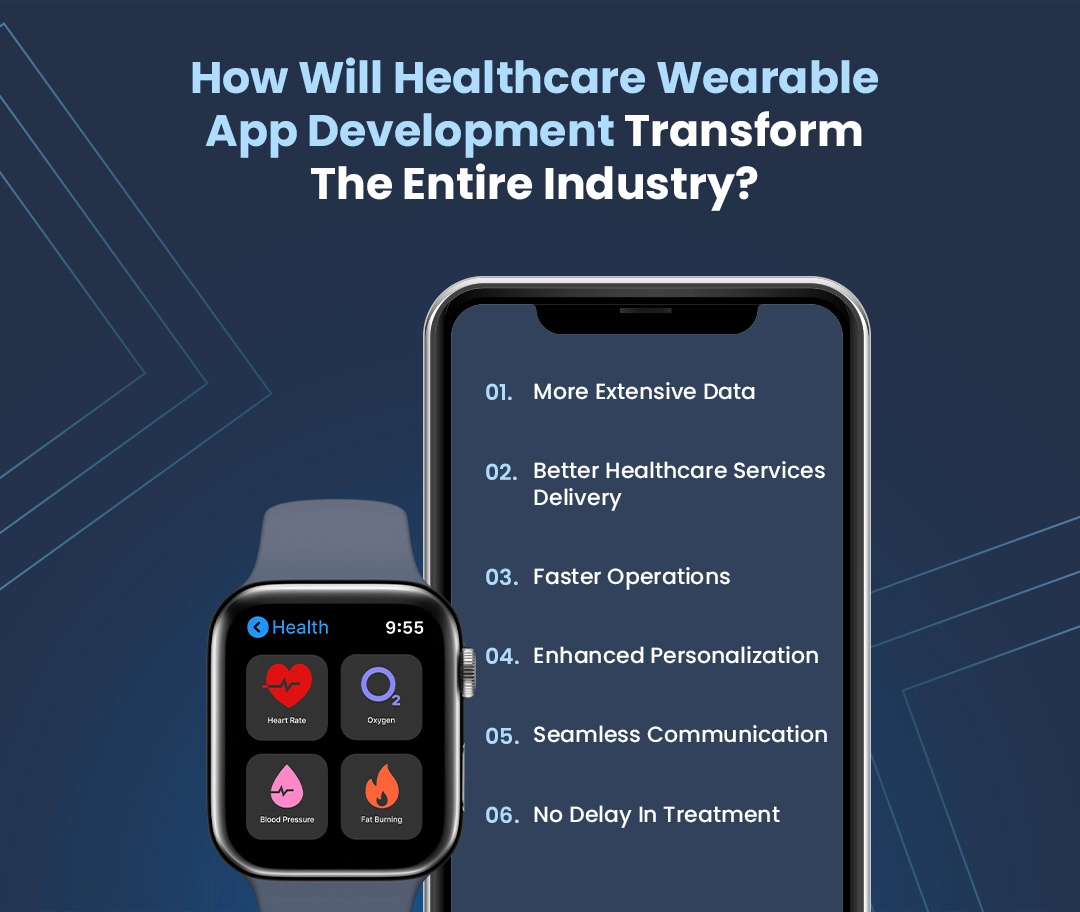
1. More Extensive Data
Wearable app development technology allows for the collection of more extensive data than ever before. By monitoring vital signs in real-time, healthcare providers can detect changes in the body before they have a chance to manifest as major illnesses and diseases. This also allows healthcare providers to be more proactive in providing care, which can reduce the duration and intensity of illnesses.
2. Better Healthcare Services Delivery
The use of wearables and the associated app development technology can help improve healthcare service delivery. Wearable apps enable patients to track their own health indicators, such as heart rate and blood pressure, which can be monitored by healthcare providers at regular intervals. This data can better inform decision-making, helping to ensure that patients receive the right care when they are in need.
3. Faster Operations
The use of wearable technologies and app development has the potential to speed up healthcare operations. Wearable apps can provide medical teams with more detailed information on a patient’s condition, which facilitates faster decision-making. Furthermore, wearables can be used as part of remote monitoring systems, allowing for the continuous tracking of data even when a patient is not in a traditional care setting.
4. Enhanced Personalization
The rise of data-driven technologies has the potential to enhance personalization in healthcare. By collecting and analyzing patient data, healthcare providers can tailor treatments and therapies to each individual’s needs. Wearable app development technology allows for even more personalized care, as data collected from wearables can be used to understand a patient’s lifestyle and habits better.
5. Seamless Communication
Wearable app development can also improve the communication between healthcare providers and patients. By utilizing connected devices, people can easily share their health data with their care team in real time. This allows for seamless collaboration between healthcare providers and patients, resulting in better treatment outcomes. Furthermore, wearables can also be used to alert healthcare providers in the event of a medical emergency.
6. No Delay In Treatment
The use of wearable app development technology can reduce delays in treatment. By collecting data in real time and sharing it with healthcare providers, patients can receive timely care. This can reduce the time it takes to diagnose an illness or condition, resulting in more successful outcomes for patients. In many cases, it’s critical to get timely treatment, and the use of wearable apps can help make that a reality.
After exploring the essential ways healthcare apps will transform the industry, let’s explore why a robust healthcare app is the need of the hour.
Why Is Having A Wearable App Essential?
With the growing complications among different devices and the need for improved user experience, wearable apps are becoming increasingly important. A personalized wearable app can be used to deliver tailored user experiences by providing an easier way to access data and interact with devices.
For instance, in the healthcare sector, an app can be used to monitor vital signs such as heart rate, blood pressure, and other important medical information. By using a wearable app, healthcare providers can keep track of their patient’s health from any location.
Furthermore, medical practitioners could send alerts and reminders to their patients through the wearable app when it is necessary to follow a specific course of treatment. Wearable apps can also be used to assist people with physical disabilities in performing everyday tasks, such as turning on the lights or unlocking doors.
From a healthcare provider’s perspective, having access to real-time data is extremely important. Wearable apps can be utilized to analyze patients’ health data, helping doctors and nurses make better decisions. Additionally, such technology can be used for remote diagnosis and treatment, which could eliminate the need for patients to travel long distances to receive medical help.
The telehealth domain will continue to expand as technology progresses. Wearable apps can also facilitate faster communication between patients and healthcare providers, allowing for a more efficient healthcare system.
With professional healthcare mobile application development services, you can integrate a variety of features into your app. Below are some of the must-have features for your bespoke wearable app.
Must-Have Features In A Custom Wearable Healthcare App
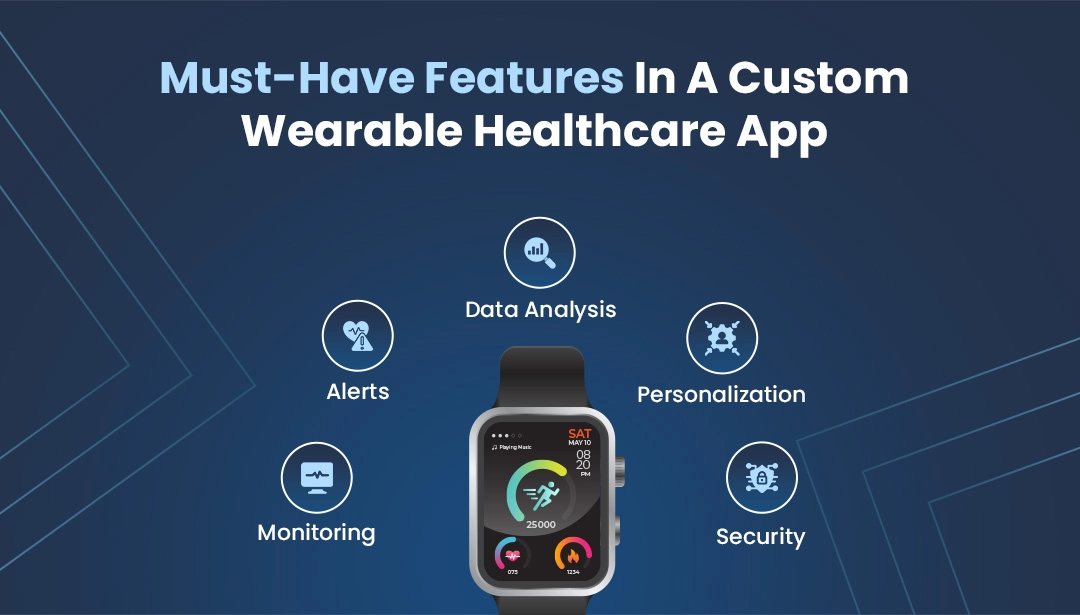
1. Monitoring
A custom wearable healthcare app should have the capability to monitor vital signs such as heart rate, activity level, and sleep quality in real time. This helps in detecting potential health problems earlier, allowing medical professionals to take preventive measures.
2. Alerts
The app should also be able to provide timely alerts if any anomalies are detected in the monitored data. This could be anything from an abnormal heart rate to a sudden drop in activity level. This can help caregivers keep an eye on their loved ones even when they’re not around.
3. Data Analysis
The app should also be able to provide data analysis capabilities that allow users to track the progress of their health over time. This can help them identify any trends that may be indicative of a health issue and take steps to address them.
4. Personalization
The app should also be able to provide personalized health feedback that is tailored to the user’s individual needs. This way, they can get the most out of their app, as it provides useful information that is specific to them.
5. Security
The app should also include the necessary security measures to protect the user’s data and ensure that only authorized personnel can access it. This is essential for ensuring the privacy of sensitive medical data and for providing the highest level of protection possible.
After exploring the features, let’s look at how much it takes to build a custom wearable healthcare app.
Cost To Develop A Wearable Healthcare App
The cost of developing a custom wearable healthcare app depends on factors such as the complexity of the project, the time frame, and the team and technology needed for the development.
It is essential to create a detailed plan of the features and expected deliverables before starting the project. On average, the cost to develop a custom wearable healthcare app is between $50,000 to $100,000. The price of creating your custom healthcare app will depend on various factors discussed below.
Factors Affecting The Wearable Healthcare App Cost
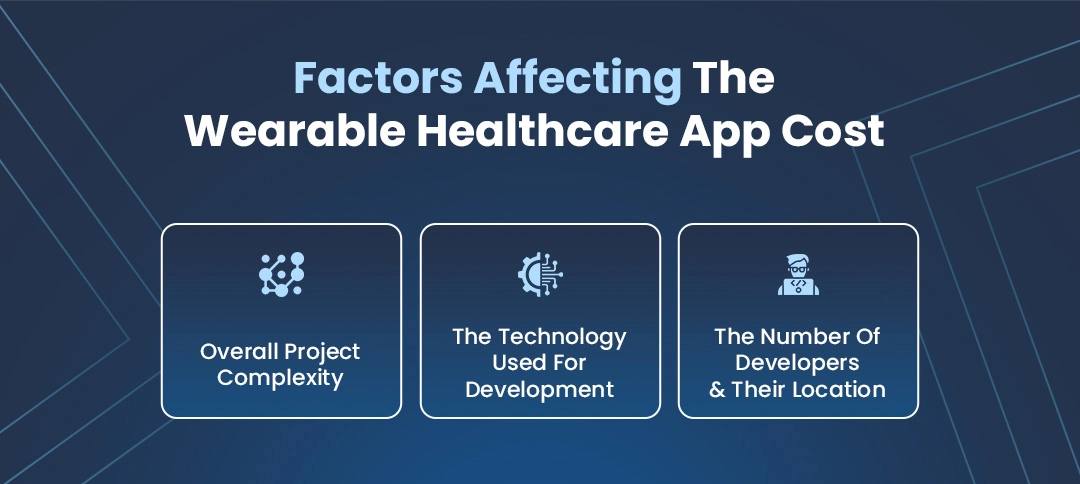
1. Overall Project Complexity
The overall complexity of the project, the number of features to be integrated, and the timeline for development are the primary factors that affect the cost. The more complex the project and features, the higher the development cost.
2. The Technology Used For Development
The technology used to develop your wearable healthcare app also affects the cost. The choice of programming language, platform, and frameworks are all factors that need to be considered when estimating the cost of development.
3. The Number Of Developers And Their Location
The number of developers needed to work on the project and their location will also affect the cost. Generally, it is more cost-effective to source developers from locations, as the cost of living in many countries is lower than in the US.
It’s crucial to hire a professional company like AGS that understands how to develop a custom wearable healthcare app efficiently and effectively.
Why Hire Auxano Global Services For Wearable App Solutions?
Auxano Global Services is a future-driven wearable app development company that specializes in creating custom healthcare app solutions. With our team of highly skilled developers and designers, we are able to create powerful apps with a wide range of features that can provide significant value to users.
We use the latest technologies to build high-quality and secure mobile apps that are tailored to your specific needs. All of our projects are designed to meet industry-standard security requirements, allowing users to feel secure when using the app.
Wrapping Up!

Wearable healthcare apps are becoming an increasingly popular way for individuals to track and manage their health. In 2024 and beyond, the demand for these apps is only going to increase. Therefore, it is essential to invest in developing a custom app that offers the features and security measures needed for the best user experience.
Frequently Asked Questions
-
1. How Much Does It Cost To Develop A Custom Healthcare App?
The cost of creating a custom healthcare app depends on various factors, such as the complexity of the project, the technology used, and the number of developers needed. On average, it can cost between $50,000 and $100,000.
-
2. Why Is Wearable Technology Important?
Wearable technology provides users with a convenient way to track and manage their health. Wearable healthcare apps allow users to monitor vital signs, track fitness goals, and access medical records quickly and easily.
-
3. Why Should Companies Focus On Building Custom Healthcare Apps?
Custom healthcare apps offer users a personalized experience that is tailored to their specific needs. Companies can capture a bigger market share by developing an app that stands out from the competition.
-
4. What Features Should A Custom Wearable Healthcare App Have?
A custom wearable healthcare app should have features such as vital sign tracking, fitness goal tracking, access to medical records, and personalized health advice.
-
5. Is It Profitable To Create A Wearable Healthcare App?
Yes, investing in developing a custom app tailored to unique needs can help companies capture a larger market share and increase profits.



